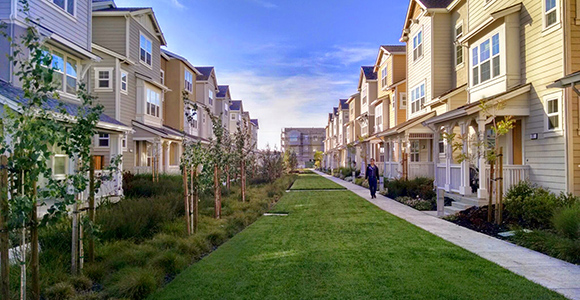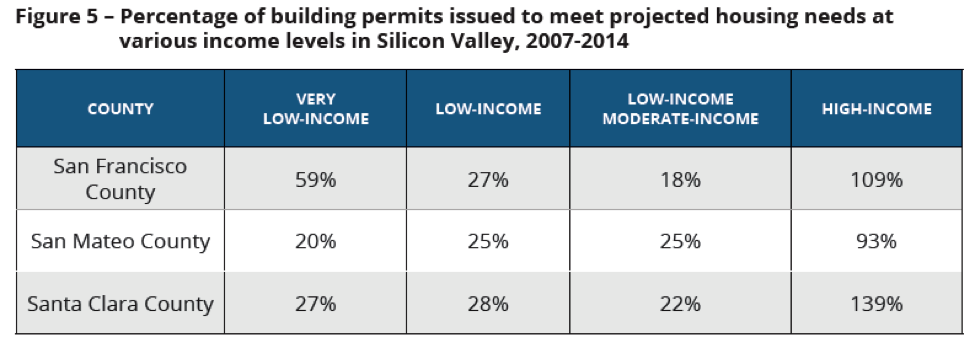
San Jose housing complex (Photo Credit: Travis Wise/Flickr)
On a day Bay Area home prices climbed to a new record (with the median home price in the nine-county region climbing to $800,000), a new report offers a glimpse of how these sky-high housing costs are impacting people's lives in the epicenter of the state’s affordability crisis: Silicon Valley.
In the report, Silicon Valley’s Housing Crisis: How did we get here, and what can we do about it?, the Silicon Valley Community Foundation and the Center for the Continuing Study of the California Economy make the case that the price of housing is now affecting, well, pretty much everybody—and every part of the region’s economy.
“Discussions about the region’s housing crisis often focus on what can be done to create more housing opportunities for low-income residents—and with good reason,” said Steve Levy, one of the study’s authors, noting Silicon Valley is producing less than a third of the units it needs to house low- and moderate-income families. “But this crisis is affecting many middle-income residents as well, and it’s moving rapidly up the income ladder.”
To understand just how much, researchers studied housing data in three counties—San Francisco, San Mateo, and Santa Clara—that together encompass most of the Silicon Valley job and housing market. Their analysis reveals five disturbing facts, which they hope will drive local and state leaders to do more to encourage communities to approve more housing all of types—while also finding ways to actually reduce the cost of housing development (something the CA Economic Summit has noted is still largely missing from today’s housing debate).
What are high housing costs doing to Silicon Valley? Five inconvenient truths.
1. It’s burdening everyone, not just poor. “When people pay more than 30 percent of income toward housing costs, they are considered ‘housing cost burdened,’ and when they pay more than 50 percent, they are considered severely housing cost burdened,” says the new report. “In San Mateo and Santa Clara counties, nearly half of all renters are housing cost burdened, and nearly 40 percent in San Francisco are in that category. Median monthly rents in those areas are $2,783 and $3,888, respectively.” To afford rents even at that low end, households need to earn at least $92,000 a year.
2. It’s pushing hundreds of thousands of people—in the Bay Area alone—into poverty. “In 2015 the poverty rate in San Mateo County was 8.5 percent (a 2.5 percentage-point increase from 2007) and 8.2 percent in Santa Clara County. However, when the region’s high cost of housing is taken into account, the poverty rate is actually much higher—17 percent in San Mateo County and 18 percent in Santa Clara County.”
3. It’s only getting worse, as rising costs outpace wages: “Between 2011 and 2016, median wages increased by 14 percent while median rental rates increased by 45 percent, with many renters experiencing even higher increases.”
4. The problem is a supply shortage: “Silicon Valley added 344,149 residents between 2007 and 2016. To keep pace with this population growth and maintain household size at the 2007 level, an estimated 130,094 units of new housing would have been needed in the region. However, only 69,503 units were issued building permits.” In other words, the region has built barely half as many houses as it needs to build.
5. Most of the houses getting built are high-priced homes for the wealthy. As the chart below shows, this is true in every part of Silicon Valley, with the exception of San Francisco, which has also found a way to build half as many units as it needs for very low-income residents—but almost no housing for low-income and middle-income workers.

This market reality has two negative consequences: 1) It means fewer new houses are affordable for the majority of residents in Silicon Valley, forcing people to leave the region or commute from several hours away; 2) It makes it that much harder to get any new housing built, since community groups, for a variety of reasons, point to the luxury-only units going up as proof that expanding supply doesn’t make housing more affordable.
This vicious cycle is at the heart of Silicon Valley’s housing crisis—and the study argues that only a combination of regulatory streamlining, expanded funding, higher density, and targeted production incentives can put a stop to it.
To read more about the report’s findings—and its proposed policy solutions—click here.

